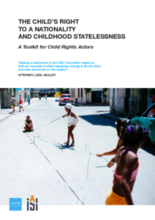This study comprises multiple elements including practical tips on how to meaningfully engage with the Committee on the Rights of the Child on childhood statelessness, complemented by a checklist, template and guidance note on how to make submissions.
It also offers additional information on the right to a nationality – one element of the children’s right to identity from birth, as enshrined in Article 7 of the Convention on the Rights of the Child.
Who is this toolkit for?
This Toolkit is designed to help civil society organisations ("CSOs"), including non- governmental organizations, national human rights institutions, ombudspersons and UN agencies, promote the fulfilment of the child's right to a nationality by leveraging the CRC framework's full potential.
Why nationality?
The right to nationality is an 'enabling' or 'gateway' right, without which it is often impossible to exercise many other rights. Denying children a nationality can have a significant impact on all other rights, including their access to education, healthcare, free movement, and family life. It is a less tangible concept that other rights issues, such as education or protection from child labour. Childhood statelessness is also a largely invisible problem: it remains unidentified in many countries and there is very little data available on who is affected. The very nature of statelessness as an extreme form of exclusion pushes stateless children to the very margins of society, from where it is very difficult to make their voices head. Preventing and resolving childhood statelessness by ensuring the right to nationality is central to any holistic approach to the promotion, protection, and fulfilment of children's rights.
Why a children's rights approach?
Each year, increasing numbers of children are being born stateless. The longer children are left without nationality, the more entrenched the impact of being stateless becomes. Addressing childhood statelessness is instrumental to tackling statelessness in general. Inherited statelessness is the greatest source of new cases of statelessness, but it is easier to resolve statelessness immediately at birth or during early childhood than later in life. As such, it is essential to tackle childhood statelessness to remedy statelessness more broadly.
What is in the toolkit?
The toolkit includes information about international obligations in relation to the child's right to a nationality, and data on the CRC Committee's engagement with this issue in its Concluding Observations. It provides a summary of the key themes referenced in CRC the Committee's recommendations, and outlines opportunities for CSOs to engage in both the Standard and Simplified Reporting Procedures of the CRC Committee. A Checklist and Template are provided to guide CSOs in submitting reports on State parties to the CRC Committee, as well as instructions on how to use ISI's database of recommendations from treaty bodies on issues relating to nationality and statelessness.
Related:

